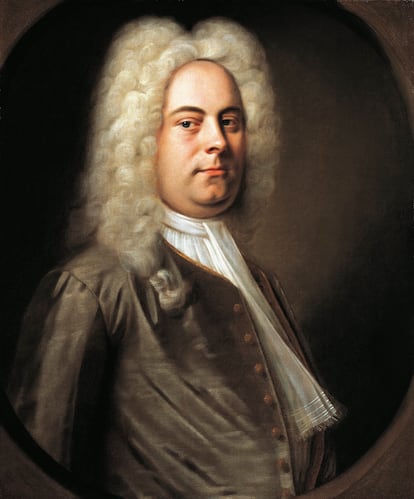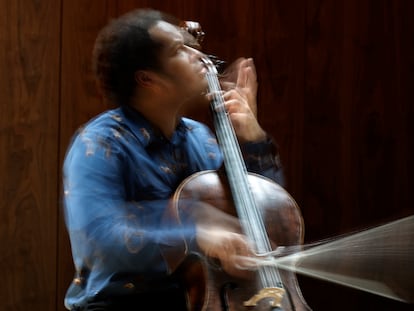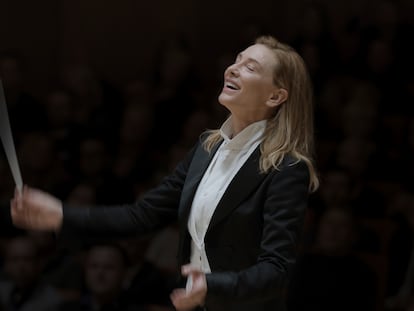A classical music hit from three centuries ago: Handel’s ‘The Messiah’ is resurrected for Christmas
The English baroque oratorio, which deals with the birth, death, and resurrection of Christ, is performed for yet another year with multiple concerts and an excellent new recording


George Friedric Handel intended to include in his popular Hallelujah “all human voices, the light and the dark, the virile tones of men and the soft tones of women, joining them and surpassing them, in rhythmic choruses, ascending and descending like on a symbolic Jacob’s ladder.” It is told by Stefan Zweig, in Handel’s Messiah, a historical miniature, written in 1937, which was later included in Decisive Moments in History. A joy choir that celebrates the triumph of Christ after his death and resurrection, included in 1741 within an oratorio linked to Holy Week, but which has ended up being one of the main musical attractions of Christmas concerts around the world.
It is not clear where or when this Handel composition began to be associated with Christmas. But the testimonies collected by Jonathan Keates, in his monograph Messiah: The Composition and Afterlife of Handel’s Masterpiece (Head of Zeus) seem to point towards the United States. In the mid-19th century it was common to hear interpretations of The Messiah in auditoriums in New York, Boston, and Chicago, every December 25. In fact, since 1993 it has also been performed as a gospel arrangement called Too Hot to Handel, which has just been performed at the Royal Albert Hall in London. The arrangement has reduced the soloists, added saxophones, electric guitar, drums, and Hammond organ. It has also shortened the work to end with the popular Hallelujah, which is sung and danced with the entire audience on their feet.
The Messiah has been performed ever since its famous premiere in Dublin, on April 13, 1742, in the Fishamble Street auditorium (now converted into the modern Handel’s Hotel). And there are many myths associated with the work and its popular choir in the almost 300 years of its history. One example is the particular custom of standing up to listen to Hallelujah, which is attributed to King George II himself in several chronicles. And there are the divine visions that the composer supposedly had while writing this popular chorus, which Zweig collected in his historical fiction, which is practically the only reference available in Spanish about the work. It is a short book that the Casimiro publishing house completes with a few pages from Romain Rolland’s biography and a shortened version of the oratorio’s libretto.

Keates’s English monograph is, by contrast, the best introduction to The Messiah. A cultural history of Handel’s work that has integrated the latest research into a simple and enjoyable story. We see this when reading the chapter dedicated to Charles Jennens, the librettist for The Messiah and the true inspiration of Handel’s score, based on his exquisite selection of biblical texts. Prepared with contributions from Ruth Smith’s book, it reveals how Jennens conceived his librettos from a deep knowledge of Handel’s music, which he avidly collected. But also how he reflected his personal obsessions and Jacobite political ideas against the reigning dynasty, both in The Messiah and in the scripts of Saul and Belshazzar.
Apart from explaining the evolution of Handel’s oratorios and the frenetic compositional process of the work over three weeks in 1741, Keates clarifies that the score of The Messiah was never closed. From the original manuscript, preserved in the British Library, it is possible to deduce the multiple variations that the composer added from the premiere, in 1742, to the last performance he conducted a few days before his death, in 1759. He never stopped making adjustments in relation to the potential of the singers, the choir, and the orchestra. We see this in the alto solo part, adjusted in Dublin to the limitations of the actress-singer Susannah Cibber, or the tenor part, reinforced for Thomas Lowe in the London premiere of 1743. But the work was not a triumph until 1749. Handel conducted it at Covent Garden in March of that year with a somewhat larger orchestra and great soloists such as the soprano Giulia Frasi and the mezzo-soprano Caterina Galli.
From then on, The Messiah became an annual charity event linked to the Foundling Hospital in London. For its first performance, in May 1750, Handel rewrote several contralto numbers for the castrato Gaetano Guadagni, who was famous for debuting the title role in Orpheus and Eurydice, by Gluck. All the vocal and instrumental parts from the 1754 performance have been preserved, and it has become the most common version of the work. But Handel’s death did not interrupt these annual performances, which grew in number and effectiveness. As early as 1784, it was performed in Westminster Abbey with a choir of 257 singers and an orchestra of 250 instrumentalists that included 16 bassoons, 12 trumpets, and 15 double basses. And it continued to grow in the Victorian era with performances that combined choirs of three thousand voices and orchestras of more than five hundred musicians at the Crystal Palace Handel festivals.
George Bernard Shaw was the first to criticize its “multitudinous clumsiness” of these massive interpretations in 1891. And he advocated restoring the work with “a choir of twenty capable artists.” Nobody paid attention to him until 1950 when John Tobin conducted The Messiah with the same forces that Handel used in the Foundling Hospital. The impression produced by listening to the work with fifty musicians was compared with the visual results of the paintings that had by then been cleaned and restored in the National Gallery. He was the vanguard of a movement that has been consolidated in the last four decades with performances informed by the work’s historical context.
Along with the avalanche of Christmas recitals of The Messiah, new recordings of the work release of the work are continually released. We have a plethora of recordings that already allow us to hear the aforementioned evolution of Handel’s score. For example, Christopher Hogwood’s canonical recording at the head of The Academy Of Ancient Music (L’Oiseau-Lyre, 1980) uses the documented 1754 version. But John Butt and The Dunedin Consort have reconstructed the version of its Dublin premiere, from 1742 (Linn Records, 2006). And even René Jacobs has tackled the 1750 version with the Clare College Choir and the Freiburg Baroque Orchestra with the aforementioned alterations for the eunuch Guadagni (Harmonia Mundi, 2011).
The veteran American conductor John Nelson, who is well known for his excellent Berlioz recordings, has just recorded his first Messiah at over 80 years old. It is a Warner Classics release on two CDs and a DVD made from a concert in November 2022 at the iconic Coventry Cathedral, the site of the premiere of Benjamin Britten’s War Requiem. Nelson introduced the event with a message of hope in the face of the multiple conflicts of the present. But there is also a new version that includes all the variants of Handel’s work, which can be heard on eight tracks with alternative arias from 1741, 1743, and 1750, since Nelson opts mainly for the versions of 1749 and 1754.
However, the most significant thing is his admirable performance leading the excellent English Concert ensemble, founded by Trevor Pinnock. The American balances the tempos, polishes the sound planes, and delves into the score at a dramatic level with astonishing effectiveness. And the recording has four exceptional soloists who combine specialized voices with opera singers. Although soprano Lisette Oropesa canceled her participation, we heard the bel canto baritenor Michael Spyres, who fascinates from the famous opening Comfort ye my people to the final duet O death, where is thy sting?, which he sings with countertenor Alex Potter. And there is no shortage of the popular Hallelujah chorus as an example of the quality of a recording that is included in the main phonographic examples of Handel’s work. And for another year, Handel’s Messiah is the hit classic Christmas musical.
Sign up for our weekly newsletter to get more English-language news coverage from EL PAÍS USA Edition
Tu suscripción se está usando en otro dispositivo
¿Quieres añadir otro usuario a tu suscripción?
Si continúas leyendo en este dispositivo, no se podrá leer en el otro.
FlechaTu suscripción se está usando en otro dispositivo y solo puedes acceder a EL PAÍS desde un dispositivo a la vez.
Si quieres compartir tu cuenta, cambia tu suscripción a la modalidad Premium, así podrás añadir otro usuario. Cada uno accederá con su propia cuenta de email, lo que os permitirá personalizar vuestra experiencia en EL PAÍS.
¿Tienes una suscripción de empresa? Accede aquí para contratar más cuentas.
En el caso de no saber quién está usando tu cuenta, te recomendamos cambiar tu contraseña aquí.
Si decides continuar compartiendo tu cuenta, este mensaje se mostrará en tu dispositivo y en el de la otra persona que está usando tu cuenta de forma indefinida, afectando a tu experiencia de lectura. Puedes consultar aquí los términos y condiciones de la suscripción digital.
More information
Archived In
Últimas noticias
Chris Martin, Taylor Swift, Elijah Wood and other famous wedding ‘crashers’
‘How does it feel to be a failure?’: Elizabeth Berkley’s journey from ‘Showgirls’ ridicule to vindication
The story of the Málaga virus: The code that haunted Google’s cybersecurity center director for 30 years
The impact of Ecuador’s mega-prison: A polluted river, cleared forests and military checkpoints
Most viewed
- Christian Louboutin: ‘Young people don’t want to be like their parents. And if their parents wear sneakers, they’re going to look for something else’
- The low-cost creative revolution: How technology is making art accessible to everyone
- Liset Menéndez de la Prida, neuroscientist: ‘It’s not normal to constantly seek pleasure; it’s important to be bored, to be calm’
- All the effects of gentrification in one corner of Mexico’s Colonia Roma
- December Social Security and SSI payments: Dates, double checks and the 2026 COLA increase










































